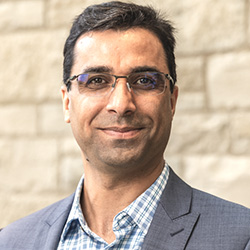Capturing Quantum Optical Information with Atomic Memories
A team led by Professor Mahdi Hosseini evaluated recent advances in quantum memory development
In classical communications, a pulse of light carries information encoded as zeroes and ones, enabling the transmission of telecommunications signals through optical fibers.
The field of quantum optical communication relies on quantum information encoded as superposition or entanglement to build a quantum Internet within a global-scale network. This type of network has applications in quantum computing, quantum communications, and quantum sensing.
A building block of future long-distance quantum network is a quantum optical memory — a device designed to store quantum information carried by photons, or particles of light.

“There has been heavy investment and effort in both government and private sectors to build a quantum network,” said Hosseini, associate professor of electrical and computer engineering at the McCormick School of Engineering. “At the same time, there are some fundamental research questions that need to be addressed, so we think this review is very timely, and can help the community see what has been done so far, learn where the field is going, and shape the future vision.”
Hosseini is also a faculty member of the Applied Physics graduate program, a joint PhD program between Northwestern Engineering and Northwestern’s Weinberg College of Arts and Sciences.
In the paper “Quantum Optical Memory for Entanglement Distribution,” published November 7 in the academic journal Optica, Hosseini and his colleagues introduced basic concepts of light storage in atomic quantum memories, outlined quantum memory protocols, and discussed recent quantum memory implementations. The paper’s coauthors include Yisheng Lei, a PhD student in applied physics at Northwestern; Faezeh Kimiaee Asadi and Christoph Simon (University of Calgary); Alex Kuzmich (University of Michigan); and Tian Zhong (University of Chicago).
The review team notes that despite significant development in recent years, more research is needed to reach the optimal performance across metrics discussed in the paper, including the fidelity of memory, efficiency, bandwidth, storage time, wavelength compatibility, and multiplexing capabilities. They suggest that a range of quantum memories may be best suited for specific applications.
Hosseini explained that quantum information is very difficult to control and store.
“Quantum information is very fragile and quantum mechanics forbids knowing what is stored,” Hosseini said. “If we have some sort of quantum information, as soon as we look at it and measure it, the quantum nature of information is destroyed. As a result, it has been a difficult task to control this type of information and find a perfect mechanism for its storage.”
There has been heavy investment and effort in both government and private sectors to build a quantum network. At the same time, there are some fundamental research questions that need to be addressed, so we think this review is very timely, and can help the community see what has been done so far, learn where the field is going, and shape the future vision.
Mahdi HosseiniAssociate Professor of Electrical and Computer Engineering at Northwestern Engineering
Fundamental research questions
The review coauthors identified several pressing research questions and fundamental challenges.
One area of inquiry is focused on how quantum information can be stored without introducing any loss or reducing the quality of information.
“We do not want to add any noise to the system. The memory should be absolutely quiet — even as quiet as the vacuum,” Hosseini said.
Another open research question involves miniaturizing quantum devices to function on a chip designed for practical applications. The team also considered factors related to compatibility with existing satellite and fiber infrastructure, as well as scalability.
“If we were to deploy this type of network and memories, we are not anticipating replacing classical communication or classical Internet,” Hosseini said. “We are trying to find a way to augment classical communication.”
The potential of quantum computing
Quantum computers promise exponential processing power over classical computers, but several orders of magnitude more quantum bits (qubits) are necessary to perform difficult computational tasks — such as applications in machine learning, scheduling, quantum chemistry, drug development, and physical simulation.
“To solve very difficult problems, you need to have powerful quantum computers, which requires millions of so-called quantum transistors or qubits entangled,” Hosseini said. “But it turns out that one alternative way to improve computation and effectively increase the number of quantum transistors working together is to connect these computers via fiber networks — the same way that we now use cloud computation or distributed computing.”
Atomic quantum memory technology, Hosseini explains, will also enable a fundamentally secure quantum network guaranteed by the laws of quantum mechanics.
“If done right, hacking or copying quantum information is fundamentally impossible,” Hosseini said. “Quantum information is fundamentally secure in the sense that it cannot be hacked or deciphered. And it's impossible to copy or amplify quantum information because that disturbs the information. And that's what makes building a quantum network and memory very difficult, because loss cannot be tolerated. You have to use a perfect protocol, perfect materials, and a well-controlled environment to store this type of information.”
A multidisciplinary approach
Hosseini joined Northwestern in June from Purdue University, where he served as assistant professor of electrical and computer engineering and director of the Innovation in Quantum Pedagogy, Application and its Relation to Culture (IQ-PARC) project funded by the US Department of Defense.
At the intersection of physics and engineering, the Hosseini Lab is currently investigating the materials systems and protocols which will offer the best performance for quantum memories. The lab is also addressing the challenges of noise, miniaturization, and device fabrication.
“One of the reasons I moved to Northwestern was because the University is very strong in materials science and engineering,” Hosseini said. “We want to bring this technology out of the research lab and into the world that is noisy, hot, and lossy. We need expertise and collaboration among engineers, physicists, chemists, and materials scientists. I'm looking forward to those collaborations.”